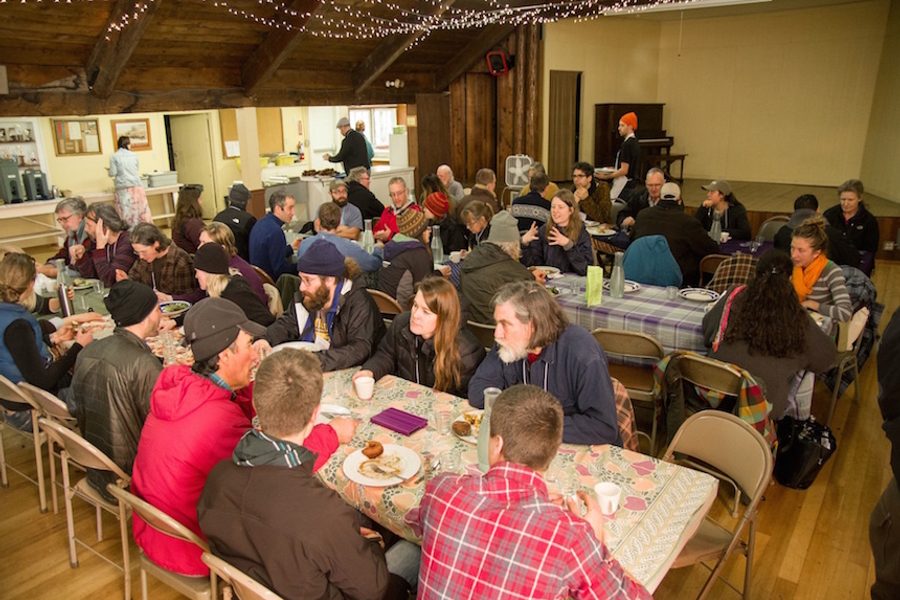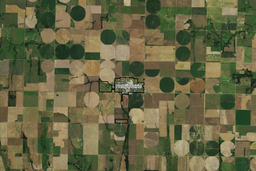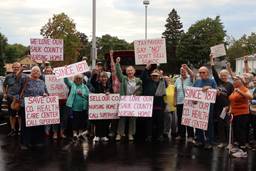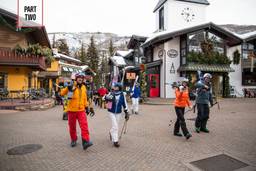West Coast Grange Wars: A Reborn Farmers’ Movement Takes on Corporate Agriculture
John Collins

As more and more grocery shoppers refuse to write-off the origins of their food as some unsolvable whodunit, a network of sustainability minded, locally oriented farmers are working to connect those people to calories from known sources. For such farmers, and those in the communities that support them, the local Grange is a well-established ally.
Jay Sexton is Master at Mary’s River Grange #685 in Philomath, Oregon. A member of that Grange for six years, he is also the current director of the Oregon State Grange Agriculture Committee, working to advance Grange policies and promote agriculture awareness. Reminding the general public that we all depend on agriculture for the food we eat has been no small part of the organization’s mission for the last 148 years.
“The Grange has an interesting history,” says Sexton, “not just with the ups and downs of membership, but with how closely it’s been tied to big agriculture.”
In recent years, a rift has emerged between some state and local Granges and the national organization. New farmers with progressive ideas regarding the future of agriculture — organic farming practices, an end to the use of GMOs, environmentally beneficial land use — are clashing with the National Grange over its support of industrial agribusiness.
Like many advocacy organizations headquartered in Washington D.C., the National Grange is politically cautious. In the Beltway, severing ties with large, technology-driven farming operations — biting the hand that feeds — is a tough sell.
“Grange policy is very clear in that we support all of agriculture,” says Ed Lutrell, president of the National Grange. “We believe that production agriculture is important to the world — it’s feeding millions of people. Local, small-market agriculture is equally as important because what the American consumer is demanding is locally grown, wholesome, safe food. We’re in complete support of that process as well.”
But those active in the new farming movement, keenly aware of the environmental perils of BigAg and champions of a wacky notion that places sustainability ahead of profit, could not care less about being cautious.
Neither could many Grangers who came before them.
In the Beginning
The National Grange of the Order of Patrons of Husbandry (referred to simply as the Grange) is the oldest agricultural organization in the United States. The group’s 11-story headquarters in Washington is, as its website emphasizes, “the only private edifice in the federal block across from the White House.” Community-based Granges still operate in 2,100 communities in 37 states. In many of them, Grange Halls — old buildings infused with a dynamic agricultural and political legacy — serve as rural community meeting places.
In 1867, Oliver Hudson Kelley (a freemason from Boston) cofounded the organization after touring struggling farms in the aftermath of the Civil War. Conditions for farmers returning home from the battlefields were bleak and Kelley, along with six other founding members, saw the need for a social and educational cooperative in rural America.
The Grange was established to increase the quality of life in rural communities by strengthening the bonds between farming families. In the beginning, Grangers set out to transcend national politics. They had good reasons. Following the near collapse of the Union, the organization emphasized the need for inclusion and established itself as a social outlet throughout rural America. Nonpartisanship was incorporated into their bylaws:
The divisions in our country created by this war, as well as union divisions, took years to heal and we strongly believe that national policy must be established through debate, but in collaboration and unity. [The Grange] must abstain from supporting candidates along the very lines that divided the country and led to the succession of the Confederate states.
But the absence of political affiliation did not, could not, last. The post-war economic landscape was changing. As the railroad expanded, production increased and the economy grew. Everybody got on board until, in an ambitious attempt to keep the good times rolling, the nation’s leading financial firms invested in the Northern Pacific Railroad. They ran out of money, triggering the Panic of 1873. What followed was known, at the time, as The Great Depression. Eventually, the even greater depression following the crash of 1929 appropriated the title. But back to 1873.
Soon, the sharing of information between rural people — disseminating economic and technological know-how among farmers in particular — was deemed vital to protecting farms from the growing power of corporate monopolies. The rise of the railroads, in particular, came with a high cost to farmers already struggling to make ends meet after the war. These farmers, many personally invested in early railroad development, were soon victimized by price-fixing and middlemen arrangements that made it impossible to efficiently harvest and transport their crops. Those who failed to cooperate were denied access to the essential infrastructure, such as grain elevators, that they needed in order to operate.
In 1875, the sense of betrayal at the hands of the railroads reached a fever pitch and Grange membership surged to more than 800,000 — its highest ever. The momentum captured by the Grange at this apex marks the beginning of what became the politically charged farmers’ movement of the late nineteenth century. An agrarian ideology — one fiercely opposed to the growing influence of big banks, corporations and railroads — spread throughout much of the country. The movement, shifting from the Grange towards regional Farmer’s Alliances that increasingly focused on rural economics, culminated in the establishment of the People’s Party (commonly known as the Populists) on July 4, 1892.
The People’s Party platform, passed at the founding convention in Omaha, put it this way:
The newspapers are largely subsidized or muzzled, public opinion silenced, business prostrated, homes covered with mortgages, labor impoverished, and the land concentrating in the hands of capitalists. … The fruits of the toil of millions are boldly stolen to build up colossal fortunes for a few, unprecedented in the history of mankind; and the possessors of these, in turn despise the Republic and endanger liberty. From the same prolific womb of governmental injustice we breed the two great classes — tramps and millionaires.
That convention nominated James B. Weaver, an Iowa congressman (and my great-great grandfather), to be the Populists’ candidate for president. Weaver ran against Grover Cleveland who was running for his second (albeit non-consecutive) term and President Benjamin Harrison. Weaver managed to win 5 states (Kansas, Colorado, Nevada, Idaho and North Dakota) and 22 electoral votes — the most electoral votes won by a third party since the Civil War. That impressive showing spoke to how Populist rhetoric resonated with voters at the time, including many black farmers in the South who supported the Populists’ opposition to the doctrine of white supremacy championed by the Democratic Party.
That same year, 1892, Weaver published A Call To Action to highlight “some of the more serious evils which now disturb the repose of American society and threaten the overthrow of free institutions.” In a sweeping philosophical critique, Weaver laments the fact that the banks, cattle barons and railroad monopolies had infiltrated all three branches of government. In an effort to “point out the exact period when the modern world became inoculated with the virus which is now threatening the destruction of free government,” Weaver compares politicians’ support of monopolies to the “lawless, degenerate and marauding” ambition of 16th century pirates. In that chapter, entitled “Evolution in Crime,” he writes:
The corporation and the wealth which it brings have become the chief concern of society and the State. … Wealth, already possessing great advantages, is not satisfied, and incorporates in order that it may have still greater power. The poor must defend themselves as best they can, single-handed and alone.
Referring to the financial arrangements between government and big business as “monstrous combinations,” Weaver continues:
They exist in every State in the Union, by thousands. They control the business of every city, thrust their paid lobbyists within the corridors and onto the floor of every legislative assembly, and importune every city council for exemptions, concession and privilege.
If there is an afterlife (which Weaver, a man of faith, strongly believed there was), I can only hope news of the 2008 bank bailouts, unlivable wages and the $5 billion dollar price tag of our upcoming presidential election has yet to reach it. But I digress.
The Grange as a Political Force
Much of what the Grange accomplished in its heyday is still visible in rural America today. In 1896, for example, after years of dogged persistence, the Grange convinced the United States Postal Service to deliver mail to rural families. The inclusive nature of the organization in regard to women was also well ahead of its time. Caroline Hall, Grange founder Oliver Kelley’s niece, is said to have told him, “Your organization will never be permanent if you leave the women out!” Kelley agreed and the Patrons of Husbandry became the first fraternal order to allow women as full-fledged members.
Politically, the Grange hit its stride around the turn of the century. A series of laws, now called the Granger Laws, were implemented in numerous Midwestern states. In all cases, though varying in their severity, the laws were attempts by the Grange to limit the rates railroads could charge. After its 1875 peak, national membership declined sharply but, despite waning membership in the ever-changing rural landscape, the order has endured. And today, on the national level, the Grange is still lobbying for or against numerous rural causes in Washington. Rural healthcare, water issues and attempts to deregulate the Internet — a digital railroad of sorts — are some of the issues of the day.
“We’ve been advocating for a number of years on the availability, access and affordability of broadband in rural America,” says Lutrell, “We’re concerned that monopolistic regulations don’t allow for innovation and expansion of broadband for all Americans in a timely fashion.”
The Grange is making progress on the national level but it’s not across the board. Depending on where you look, some Grange Halls have closed and some are hanging on by an aging thread. Others, however, are thriving in response to a burgeoning interest in sustainable agriculture.
The Rebirth of Mary’s River Grange
In 2009, Mary’s River Grange in Oregon was on the brink of shuttering its 80-year old hall. Its survival is a local success story.
“The hall was going to fold,” says Sexton, “it had a few older members but just wasn’t gaining enough new interest.”
That changed when one of the youngest members at the time, John Eveland — an organic farmer in his fifties and owner of a successful farm on Grange Hall Road — took it upon himself to save the fledgling chapter.
“He went out and beat the bushes — asked all of his friends to join the Grange,” says Sexton, who wasn’t yet a member. “He figured: how could you live on a Grange Hall Road without a Grange Hall?”
Eveland and his wife run Gathering Together Farm. Their operation includes a farmstead, a CSA (community supported agriculture), a restaurant and catering business, as well as numerous stands at farmer’s markets throughout the state.
“I knew that if it folded, it would revert back to the state Grange and get sold or torn down and the whole thing would go away,” says Eveland, “At the very least, I saw it is a community resource — a place for community events.”
The founding principles of the Grange, Eveland says, always resonated with him. When it became clear old members had given up hope, he started rounding up new ones. In response to his efforts, 15 new members joined Mary’s River Grange. Others joined in the following months, including Sexton — a number of them were young people new to farming. But not all Mary’s River Grange members are active farmers.
“About half of our members are employed in specialty seeds or organic farming. The other half is interested in local, healthy, sustainable food,” says Sexton.
Last year, the Benton County Community Rights Coalition (the county which includes Philomath) submitted for a public vote an ordinance to ban the open planting of genetically modified crops within the county. Measure 2-89, otherwise known as The Benton County Local Food System Ordinance, was an attempt to challenge earlier Oregon state legislation that forbid communities from enacting such bans.
Opponents of the bill saw it as a threat to their right to plant whatever they want. Organic farmers and community members who supported the measure, however, maintained it was a chance to protect their local food supply from biotech patent holders driven by a complicated combination of profit, profit and profit. After discussing the issue, Mary’s River decided to throw its support behind the measure.
“A lot of our members are concerned about GMO contamination in the field in which they work — specialty seeds or organic farming,” says Sexton. “But we also had a state labeling law last November that, despite the opposition being heavily funded by big agriculture, like Monsanto, was only narrowly defeated. Many of us think it’s important to take a stand against that kind of influence.”
Spending millions of dollars to influence legislation on the national level, agricultural or otherwise, is old news. But supporters of the ban were disappointed. On May 19, Benton County voters failed to endorse the ban 27 to 72 percent.
“I voted for it,” says Eveland, “but it was a flawed bill that tried to take on too much. I do think patenting plant characteristics is a lousy idea. Personally, I think most of this GMO thing is really about Roundup — reworking plants so you can spray more pesticides on them without them dying.”
In stark contrast to Mary’s River Grange support of the Benton County Community Rights Coalition’s attempt to ban the open planting of genetically modified crops, the National Grange recently lauded the Supreme Court’s decision to side with Monsanto when the company sued an Indiana soybean farmer for violating one of their patents.
In May 2014, the court in Bowman v. Monsanto—one of numerous cases involving patents held by the corporate giant’s agrochemical and biotechnology divisions — ruled that Vernon Bowman’s repeated use of the “self-replicating properties of their genetically modified soybeans did not excuse him from paying for new seeds every year.”
The National Grange’s support of the Supreme Court ruling embodies the growing tension between the national organization and some of its local charters, but it’s far from the most contentious example.
Revolt of the California State Grange
The four-tiered structure of the Grange — local, county (also called the Pomona Grange), state and national — is such that there are no top-down implementations of policy. Autonomy constitutes the charm, if not the very spine, of the Grange philosophy. But dissension in the ranks does not go unnoticed. Nowhere has the clash between new blood and the old guard been more contentious than the Golden State.
In the late 1990s, young farmers in California began taking an interest in their local Granges. Chapters in communities like Aromas, Garden Valley, Sebastapol and Willits, which were previously stagnant or dying-off, began attracting new members; marking the beginning of a grassroots renaissance in the California State Grange.
“Meanwhile the National Grange remained stagnant,” says Takashi Yogi, who in 1998 joined the Santa Cruz Live Oak Grange. “There was a brief period of progress under National president Kermit Richardson, who instituted an Action Grange program to promote change. But California and National were moving in opposite courses, ultimately headed for collision.”
In 2009, California grangers elected Bob McFarland as their State President. Under his leadership, numerous resolutions supporting organic farming and opposing GMOs were passed. In 2010, a surge in new members reversed the trend in declining state membership for the first time in 30 years. Perhaps more tellingly, the average age of the California granger dropped from 65 (in 2008) to 45.
“We’ve seen a complete resurgence in interest in the grange from young people and organic farmers — people farming five acres or less, selling their food at local markets,” says McFarland. “And the bulk of these new members are young farmers that are the sons and daughters of those farmers who used to have the family farm back in the ’50s and ’60s that got sold to corporations. They haven’t had anywhere to practice the craft that’s in their blood. By reinventing the grange and reaching out to these folks we were able to grow.”
In 2011, however, despite widespread support for McFarland by a majority of California Grangers, the relationship between McFarland and National President Ed Lutrell began to unravel. More accurately (in the usually quiet Grange universe) all hell broke loose.
“I’m either the worst outlaw that ever lived or there’s something wrong here,” says McFarland, referring to the series of charges Lutrell and the National Grange has brought against him and the California State Grange in recent years. It’s a complicated story (one that warrants, if not a book, its own article) but here are the cliff notes: In 2011, a small group of California Grangers, dissatisfied with the direction McFarland was headed, and citing violations of the Order’s bylaws, took their grievances to Lutrell. At his request, an Executive Committee (EC), consisting of California Grangers was formed to look into the matter. In January of 2012, the EC sent its findings back to Lutrell. Their conclusion: “No Grange violations indicated.” Lutrell saw things differently, however, and suspended McFarland for June and July of 2012. But when he returned to office, so did the efforts to remove him. In August, McFarland received a prewritten letter of resignation from the National Grange. Believing that the accusations were, at best, trivial, McFarland refused to sign it. (For a detailed account click here.)
In April of 2013, Lutrell revoked the state’s 145 year-old charter — effectively severing about 10,000 members in 206 chapters — one tenth of the total Granges — from participating and voting in the larger organization.
“When you get into why the charter of the California State Grange was suspended, then revoked,” says Lutrell, “it was because they chose not to follow the rules of the organization. And an organization that has no rules has no structure and no future. They refused to follow the rules: willing, knowingly, etc.”
In response, in the fall of 2013, McFarland gathered state delegates to discuss the California State Grange’s options.
“I asked: ‘What do you want to do folks?’ ” says McFarland, “Our national charter has been revoked. Do you want to continue working together as the Granges of California or do you want to fold up our tents and go home.”
Those delegates unanimously voted to keep working together as the California Granges. Meanwhile, 95 percent of members in 185 of the state’s 206 Granges — spanning from the far south to the Oregon border — voted to reelect McFarland to his third term..
Numerous lawsuits are now pending in state and federal court. One case, dealing primarily with property and assets, is slated for review in the California Superior Court this week. Since the California charter was revoked in 2013, Lutrell has demanded that the California State Grange turn over its buildings, property, bank accounts and, naturally, that the state’s elected officers stop working.
“They are claiming that we have no authority,” says Lutrell, “that our ability to charter them is meaningless. But all assets of the Grange are required— under American law, California law and Grange law — to stay within the organization. They’ve refused to acknowledge that. So the National Grange is merely asking that those assets get turned over to those who are duly authorized to manage them.”
This is not how McFarland sees it. “They like to spin this that we voluntarily mutinied and disaffiliated with the National Grange, but we absolutely did not,” he says. “I don’t know how you disaffiliate with an organization you’ve been kicked out of.”
There’s another lawsuit in federal court pertaining to trademarks. The National Grange has instructed the California State Grange to stop using not just the national logo but even the word “Grange.”
“We are not using the national logo. We have our own so that’s not a problem,” says McFarland, “but we’ve been using the name Grange since 1870 and we’re not going to give that up so readily.”
Additional litigation is also pending between the California State Grange and the recently reinstated Granges of California Patrons of Husbandry—a group of 24 granges that demonstrated a willingness to cooperate with the National Grange and that Lutrell selectively reinstated last July.
Amid the hail of lawsuits, the presidents of the California State Grange and National — McFarland and Lutrell respectively — acknowledge how unfortunate the ongoing division is. Indeed, like an acrimonious divorce, the only people winning, at the moment, are lawyers. But the stakes for the 148 year old institution are high. While broad consensus can be found regarding what the Grange once was, differing ideologies now compete for what it will be.
Back to the Grange
On one hand you have an established order that, while quick to conjure its Populist origins, appears threatened by the kind of grassroots change it once championed. On the other, a contingent of rogue Grangers — progressives decidedly less interested in nostalgia than their national counterpart — attempting to breathe new life into an aging system that doesn’t seem to want the CPR.
Severine Von Tscharner Fleming is a farmer, activist, organizer and founder of Greenhorns — an organization with the mission to “recruit, promote and support the rising generation of new farmers in America.” Last year, the group launched Grange Future, a project that compiles the history of the Grange while envisioning its potential usefulness for the next generation.
“There’s a contestation around what the Grange will be,” says Von Tscharner Fleming. “Right now, the Grange present is captured by a pretty corporate voice. The original Populist voice of the Grange is not present on the national level. We called our project Grange Future because we’re claiming an interpretation. We’re saying: the future’s a long time and we’re going to be here and we can use these buildings and this infrastructure.”
If history’s any kind of barometer, the question of what path the Grange will take will be answered on the local level. The strength of the organization has always rested on the decentralized nature of its local chapters finding common ground. When united that strength becomes a force. Perhaps like progress at large, time is working both for and against the Grange.
“What we see on the ground,” says Von Tscharner Fleming, “is an intergenerational collaboration to keep the Grange going. But if you look at who are the stewards and guardians of these institutions, it’s often people in their seventies and eighties.”
Commitment to the organization, for many, is a lifelong undertaking. And without those who stuck by their Grange as American agriculture evolved in the 20th century, today’s debate might not even include the Grange concept. But age isn’t always aligned with its conventional wisdom. The Grange has broad appeal. Lanny Cotler — a Vietnam vet who, on the 4th of July, will turn 74 — joined Little Lake Grange #605 in Willits, California, 12 years ago. Here’s what he has to say about the California Grange war:
The entrenched powers fear that if the California Grange vision infects the other states, they will no longer be able to maintain power and control. They won’t be able to lead, because they lack the expertise and the progressive populism that the new relevancy demands. They are experts of the old time — cookie sales and even good community service work. But they don’t have the ability or even the interest to attract back-to-the-land Grangers, especially young people. Young people don’t want to join an organization that is run by a Good Ol’ Boy Network.
Renewed interest in local agriculture is what the Grange needs to reverse a decades-long decline in membership, but young farmers who gravitate toward the organization’s preexisting (ancient by the standards of Millennial farmers) institutions are bringing a different political point of view to the field, even if all they really want to do is grow (and eat) a better kind of food.
“This whole move towards localization and organic farming — the campaign to have GMOs labeled — has been big on our radar,” says McFarland. “We are anti-pesticide, anti-fracking but we are for food sovereignty. The National Grange is dynamically opposed to all of those. They are pro-GMO, pro-pesticides, pro-big farming as opposed to small and local farms. Politically there is a dynamic difference.”
It is a difference that Lutrell plays down. “In the grange, one of things you need to understand is that disagreements and discussion and differences of opinion are to be encouraged, not discouraged,” he says. “The one thing that frustrates me is the intolerance I see in many segments of our society — that if you don’t agree with us you’re against us. But in the Grange we believe that the bonds of the fraternity bring us all together.”
Von Tscharner Fleming, who hopes the revival of the Grange goes hand in hand with a new kind of agriculture, also sees the importance of unity.
“As young farmers, we’re not really interested in getting involved in a lot of politicking,” says Von Tscharner Fleming. “For those of us who want to build a new system, we see the future of the Grange as providing the core facilities to do that within the old system. And we think we can do it while using the lineage, legacy and example of this powerful institution.”
(Sign up for the Rural America In These Times newsletter at the top of this page to be notified of our ongoing coverage of the Grange movement.)








